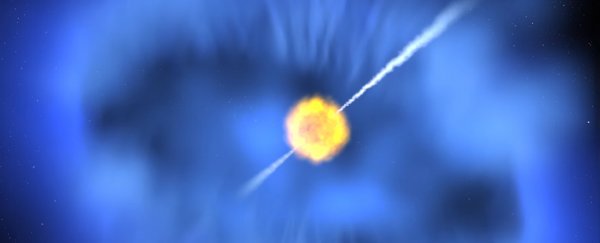As far as supernovae go, AT2018cow - detected last year - was among the brightest ever seen. The flash was so intense, some mistook it for an explosion inside the Milky Way.
In the event's wake, all eyes turned to the expanding wave of debris to better understand the cause of this extreme flash. Now, experts have just presented their arguments: it's either a murdering black hole or the birth of one.
So what is this cow event, exactly? On 16 June 2018, the astronomy world was rocked by an unusually bright transient event captured by the Hawaii-based ATLAS survey.
At least 10 times brighter than your run-of-the-mill exploding star, with intensities across the spectrum, some suspected it had to be inside our own galaxy.
The site of the explosion was soon traced to a star-forming galaxy called CGCG 137-068, roughly 200 million light years away in the constellation Hercules.
"This was an incredibly luminous event, brighter than almost any supernova we've ever seen before," says astronomer Daniel Perley from Liverpool John Moores University in England.
The event was coded AT2018cow, a name that was quickly shortened to something a little more whimsical.
"The Cow also appeared and faded away very quickly, so quickly that existing supernova models can't properly explain it. It must be a new type of extremely energetic, explosive event," says Perley.
With the race on to determine exactly what sparked The Cow's intense flare, astronomers turned to other sources of data in an effort to analyse the glow of the explosion's aftermath.
Perley's team used a network of optical telescopes that form part of the Global Relay of Observatories Watching Transients Happen (GROWTH) program, keeping track of The Cow's mess for a month after its appearance.
Another team used the CSIRO's Australia Telescope Compact Array to collect information on other parts of the light spectrum.
"Our radio data shows that the shock wave is travelling at about one-tenth the speed of light," says University of Sydney radio astronomer, PhD candidate Dougal Dobie.
The intensity and signatures in the data from the flash have inspired a variety of potential explanations that point to various 'engines' providing the event with the energy required.
"Whatever it is, it must involve some form of energetic and very fast explosion interacting with an extremely dense shell of material very close to the explosion progenitor," Perley pointed out at a recent meeting of the American Astronomical Society in Seattle.
NASA researcher Amy Lien and her colleagues, who used data from multiple NASA sources including the Neil Gehrels Swift Observatory, think all signs point to a black hole hundreds of thousands time the mass of our own Sun swiftly assassinating a white dwarf.
"We think a tidal disruption created the quick, really unusual burst of light at the beginning of the event and best explains Swift's multiwavelength observations as it faded over the next few months," says Lien, whose work is set to be published in an upcoming issue of the Monthly Notices of the Royal Astronomical Society.
Meanwhile astrophysicist Raffaella Margutti from Northwestern University in Illinois has her money on the birth of something new.
"Based on what we saw in other wavelengths, we think this was a special case and that we may have observed – for the first time – the creation of a compact body in real time," says Margutti.
While the term 'compact' makes this sound like a small car, we're actually talking an ultra-dense, rapidly spinning neutron star - or even a black hole.
Events that are suspected to have given birth to such monstrous bodies aren't commonly captured by telescopes. But with so much attention devoted to The Cow, astrophysicists would have an unprecedented view.
"We looked at this object with many different observatories, and of course the more windows you open onto an object, the more you can learn about it," says Margutti's co-author, Brian Grefenstette.
It's clear the debate is only warming up, as researchers pile in with new data and fresh arguments on what caused AT2018cow to glow so fiercely.
Whatever the outcome, The Cow continues to stand out as a landmark event in astronomy.
